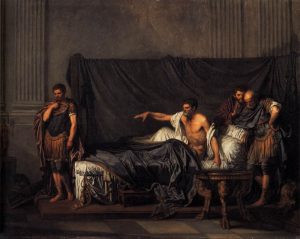
Jean-Baptiste Greuze, Septimius Severus and Caracalla (1769), oil on canvas, 124 cm x 160 cm, Louvre Museum (Image File from Wikimedia Commons)
The Deutsches Forum für Kunstgeschichte Paris (DFK Paris) is pleased to present the database of the art collection of the Académie royale de peinture et de sculpture. Over the century and a half of its existence (1648–1793), the Académie royale assembled a collection of more than 650 artworks (paintings, sculptures, prints, drawings, casts, and medals). Most of those were morceaux de réception – works that young artists presented to an academic jury to become members of the institution. But the collection also included Prix-de-Rome-wining paintings and bas-reliefs, commissioned portraits of the Académie’s patrons, académie drawings of current and past professors, plaster casts of classical sculptures, miscellaneous donated works of art, and artistic marginalia (e.g., skeletons used in teaching human anatomy).
This was a one-of-a-kind corpus for multiple reasons. As almost all the prominent artists of the old regime were members of the Académie royale, it united such iconic reception pieces as Antoine Watteau’s Pilgrimage to the Isle of Cythera (1717), Jean Simeon Chardin’s The Ray (1728), and Jean-Baptiste Greuze’s Septimius Severus and Caracalla (1769). These and other examination works now offer invaluable insight into the aesthetic values of the institution. Académies, plaster casts, and other objects used for teaching allow us to reconstruct the educational process, and commissioned portraits of the Académie’s patrons and donated works of art shed light on the personal networks behind it. The hang of these artworks in the Louvre is an outstanding example of eighteenth-century curatorial work: it was decided upon by academicians themselves and stands as an important “internal” counterpart to the Académie’s public display, the Salon.
After the French Revolution, this historically significant body of work was dispersed and today is shared by the Louvre, the Versailles, the École Nationale Supérieure des Beaux-Arts (ENSBA), and many other museums in France and worldwide. Thankfully, however, two detailed descriptions are still extant: in 1715, when the collection was housed on the Louvre’s ground floor, it was documented by Nicolas Guérin, and in 1781, when it hung on the first floor, it was recorded by Antoine-Nicolas Dezallier d’Argenville.
Using these two inventories, the DFK Paris in collaboration with Sofya Dmitrieva, Anne Klammt (Hannah Arendt Institute for Totalitarianism Studies), Moritz Schepp (CEO Wendig.io), the Centre Dominique-Vivant Denon (Musée du Louvre), the ENSBA, and the Institut National d’Histoire de l’Art (INHA) has created a database that establishes what artworks made up the collection in the eighteenth century and where they are preserved now. The database provides useful links to the original texts of the inventories and to the Procès-verbaux. It is available in English and in French and would be of great use to scholars of eighteenth-century French art.
This database is part of the DFK’s research project, led by Markus A. Castor, that explores the history and functions of the Académie’s art collection.
